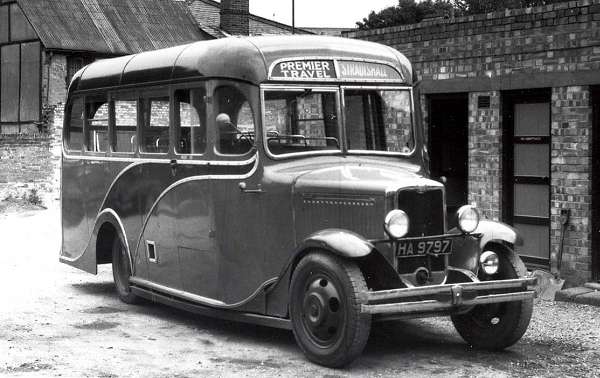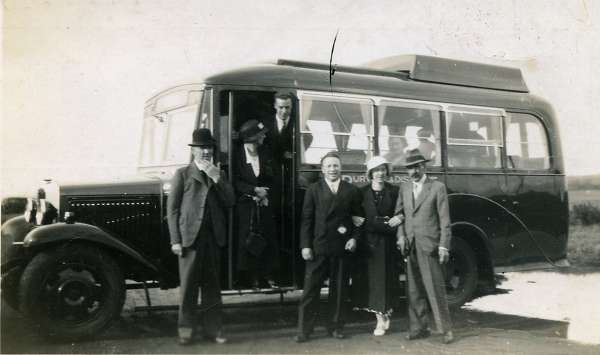Burwell & District Bedford WLB

Since not being able to get out and about much recently I have tried to fill in some gaps in the history of Burwell & District vehicles. One bus that I am still uncertain about is Bedford WLB HA 9797. The PSV Circle records it as having a Bush & Twiddy body C20F new in 1934 to B&D in 6/34. I have vague mention from elsewhere that it did not arrive at Burwell until 1935.The body make has also been questioned but most reference is to Bush & Twiddy.
The Smethwick registration HA suggests it was not new to B&D, so I wonder if anyone has any suggestions? One suggestion is that it might have been bodied by Auto-Cellulose, as they were from Smethwick?
I attach a pic attributed to Joe Higham used in Paul Carter`s book on Premier Travel, who later owned it.
Does anyone have a pic of another Bush & Twiddy WLB or even one bodied by Auto-Cellulose to compare with this one?
Jim Neale
If you would like to comment on the above please click here
02/03/16 - 06:27
Jim, I'm sure you'll already know far more about HA 9797 than I've been able to ascertain. You'll know that it is mentioned in PSVC publication C1250 (Bedford 1930s production) and that it passed to Premier Travel with the business of Burgoin of Haverhill (Grey Pullman) in December 1949.
As for Auto-Cellulose bodies, Brian Asbury (b.1933) reported in 2012 that he was in possession of a set of photographs of vehicles bodied by that company. Brian would now be aged 82/83, so I obviously can't guarantee he'll still be around.
I believe that, at one time, Auto-Cellulose did have quite a strong local customer base. See this link http://www.localmouth.com/go/swan-village/show_topic?topic_id=8198
David Call
02/03/16 - 11:03
David, Thanks for your suggestion, I have replied to Brian Asbury with my question, hope for a reply! I have tried researching Bush & Twiddy but nothing much in the usual searches, shame as Eaton, another Norwich coach builder of the period has an extensive and informative website.
Jim Neale
04/03/16 - 16:51
I donít think its a Bush & Twiddy body, here is one on a 1930 Chevrolet https://www.flickr.com/photos/ and what looks like another on a 1935 WLB (GV 3447) at Finchingfield http://www.imcdb.org/
John Wakefield
05/03/16 - 05:20
Like John W, I think that the body on this Bedford is decidedly dissimilar to other examples of Bush & Twiddy to be found on the internet. However, this truly extraordinary body on a pre war Austin is believed to be a Bush & Twiddy creation, so absolute certainty is difficult:- http://nonsequitur.freeforums.org
Roger Cox
05/03/16 - 09:23
Oh dear Roger, I don't want to seem too harshly critical but I don't think I've ever seen anything more abominable as the "body" on the prewar Austin. It looks rather like a party jelly which has had a nasty fall !! I wonder if any of Boris's ancestors had anything to do with it.
Chris Youhill
05/03/16 - 11:26
Thanks for suggestions, I am more inclined to follow the Auto-Cellulose with the Smethwick registration, would be nice to have something to compare with?

There was also confusion with another WLB that B&D bought new in 1935 AVE 549, chassis no. 109983 with a body by Willmott of Hammersmith, another somewhat obscure coachbuilder which I attach for comparison.
Jim Neale
05/03/16 - 11:27
This might seem an odd question, but I wonder if anyone can say how it is known that the body on 'VF 8157' is by Bush & Twiddy? Is it through some marking on the actual vehicle, or from some document? Don't forget that Jack Mulley apparently admitted to having done some registration swapping, so I'm not sure how certain it is that 'VF 8157' is really VF 8157 at all.
The body on 'GV 3447' (which looks more like GY 3447 on the only shot I have seen on which the registration is visible) is thought to be Bush & Twiddy only because in some respects it resembles that on 'VF 8157', so we have potentially two complete red herrings here. In any case, the bodies on the above do not at all resemble that on HA 9797, so that doesn't really get us any further towards establishing the make of body on the latter.
David Call
05/03/16 - 12:21
David, The registration on the Finchingfield WLB is definitely GV 3447 (a West Suffolk reg.) as seen in this close up http://pics.imcdb.org/10314/05-40busb.jpg
John Wakefield
05/03/16 - 17:15
Thanks for clearing that one up, John - I hadn't realised that the smaller pics on the IMDb page were clickable. On the shot which is already enlarged there looks to be something partly obscuring the 'V', I can't see anything on the vehicle it could be so may be a mark on the film.
David Call
05/03/16 - 17:47
The 'abominable' prewar Austin (CAY 526) in the link to which Roger and Chris refer is also pictured in John Carman's book 'Austin K Series Buses & Coaches'. It is given as being a K3/CL supplied to W.H. Patch's Cream Bus Service of Stamford in April 1940, and with bodywork 'in the avant-guard style' by Brush. I must say that it would seem rather out of character for Brush, who tended to produce fairly conventional looking bodies. Maybe someone has confused Brush with Bush (& Twiddy) - but who's right?
John Stringer
06/03/16 - 05:40
Pictures of Auto Cellulose bodywork are exceedingly hard to find. Here is an example from 1936 on a Leyland Tiger (probably a TS7). The accompanying text states that Duple contemplated taking action against the Smethwick firm because of the visual similarities to the Hendon product. The picture of the Burwell Bedford does suggest some Duple-like characteristics, and the treatment around the driver's side window is similar to, though not identical with, that on the 1936 Tiger. When the WLB came on to the market in 1931, General Motors recognised Duple as the main supplier of 20 seat bodywork for this model, and most WLBs were so equipped. However, the preserved Duple bodied WLB, CMG 30, is different from the Burwell machine (the picture is about a quarter of the way down the page):- which is at this link.
Roger Cox
07/03/16 - 17:09
That poor little Austin. Fancy inflicting such strangely styled coachwork on such an innocuous little chassis. The window 'pairs' look as if they were actually made from the rear bulkhead windows of two coaches, albeit of slightly different types, with the rearmost one looking not unlike that of Duple. The vehicle has the feel of one of those metalwork tests undertaken by apprentices of old, to check their metal cutting and welding skills, using whatever shapes and metals were to hand in order to construct a 'sample' for inspection. The unfortunate little Austin probably only dared venture out at night. Maybe it had a happy ending, with the coachwork being replaced at an early stage by a neat-looking dropside lorry body. I do hope so.
Brendan Smith
08/03/16 - 05:33
In my posting above, I forgot to include the link to the Auto Cellulose body on the Leyland Tiger, so here it is:- www.flickr.com/photos/
Taking up the point raised by John S about the true perpetrator of the bodywork aberration on the unfortunate Cream Bus Service Austin, Brush was a very well established volume constructor whose products followed a pretty standard specification. Most of their output consisted of buses, though a few coaches were included. However, I believe that all their bodies had a straight waistrail, and I cannot conceive that the extreme eccentricity of that Austin body would ever have been countenanced by the Loughborough firm. Indeed, had such a 'design' escaped official scrutiny, I should imagine that the person responsible would have been summoned to the management inner sanctum, and, from there, frogmarched to the exit gate where letters of introduction to all Brush's competitors would have been thrust eagerly into his hand. As David Call has suggested in his note above, provenance of the identity of many of the small coachbuilders is always uncertain, but Bush & Twiddy is surely more probable than Brush in this case. I do think that Brendan has identified the origins of those odd side windows. The acuity of the contributors to OBP makes this site so valuable.
Roger Cox
09/03/16 - 08:35
I wonder if the date of registration for the Austin of CAY 526 has some significance. It is Quoted as being registered in April 1940, but the first CAY mark was issued in that month, so late 1940 would seem to be more likely. One year into the war, its unlikely that construction of such an extravagant body would have been commenced, so is this pre-war design exercise that only became an attractive proposition to an operator when the supply of new vehicles dried up?
David Hick
10/03/16 - 04:59
That's a good point, David. When war began in 1939, many suppliers to the automotive industry switched resources to military output, but others, including some bus bodywork manufacturers, continued to manufacture limited quantities of their standard product. By mid 1940, with the war situation worsening, material shortages dictated the effective end of bus production. Is it not possible that, under such constraints, the idiosyncratic body on CAY 526 was assembled from such bits and pieces as were still to be found lying around.
Roger Cox
10/03/16 - 12:55
I know we've deviated somewhat from the Burwell & District subject here, but... Going back to John Carman's book it states that CAY 526 was recorded as having chassis number 22416, which would date from mid-1941. 2241 was a K3CL (this was the coach chassis) built 9/39 and claimed as a goods vehicle BRD 83. Chassis 2246 was a K3/VT lorry. 2416 was a K30/VT lorry (also 30cwt, so not appropriate).
It seems likely that CAY 526 was a coach chassis but originally supplied as a lorry BRD 83, then rebodied with the Brush(?) body by 4/40 and reregistered.
Maybe Brush had seen an opening in the market for an alternative coach body to the Duple Vista but thought that it would need to have what we might now call the 'wow factor' and started to put together this experimental monstrosity when war broke out and thankfully halted any further development. Someone then found out about it languishing in a corner of the Brush works and with new single deckers being in short supply by then saw fit to mount it on their conveniently coached spec'd lorry chassis.
Since John Carman's book appeared in 2014, the PSV Circle have recently published their own book of Austin PSV chassis production, so it would be interesting to know what it says on the subject.
John Stringer
Comments regarding the above are more than welcome please get in touch via the 'Contact Page' or by email at
All rights to the design and layout of this website are reserved Old Bus Photos does not set or use Cookies but Google Analytics will set four see this
Old Bus Photos from Saturday 25th April 2009 to Friday 19th April 2024